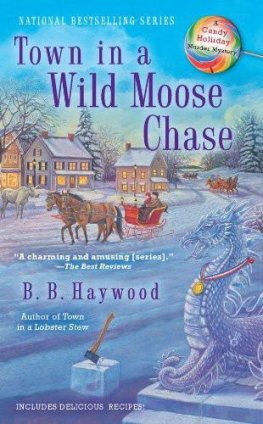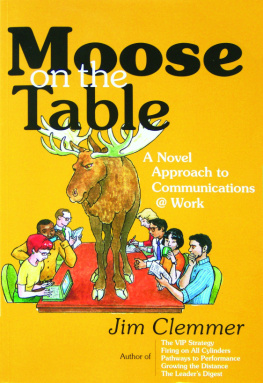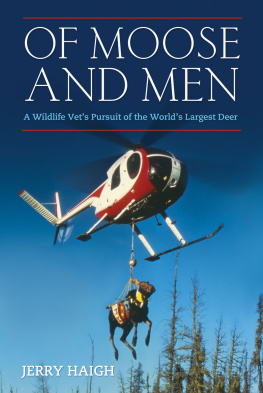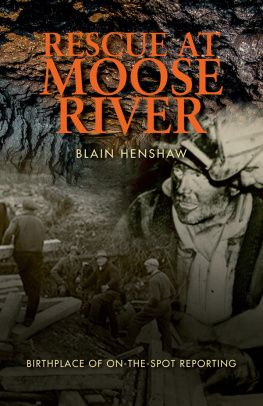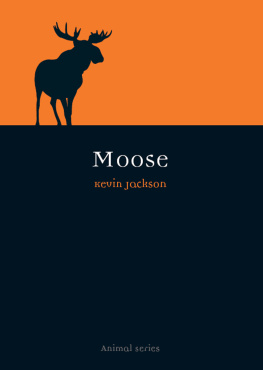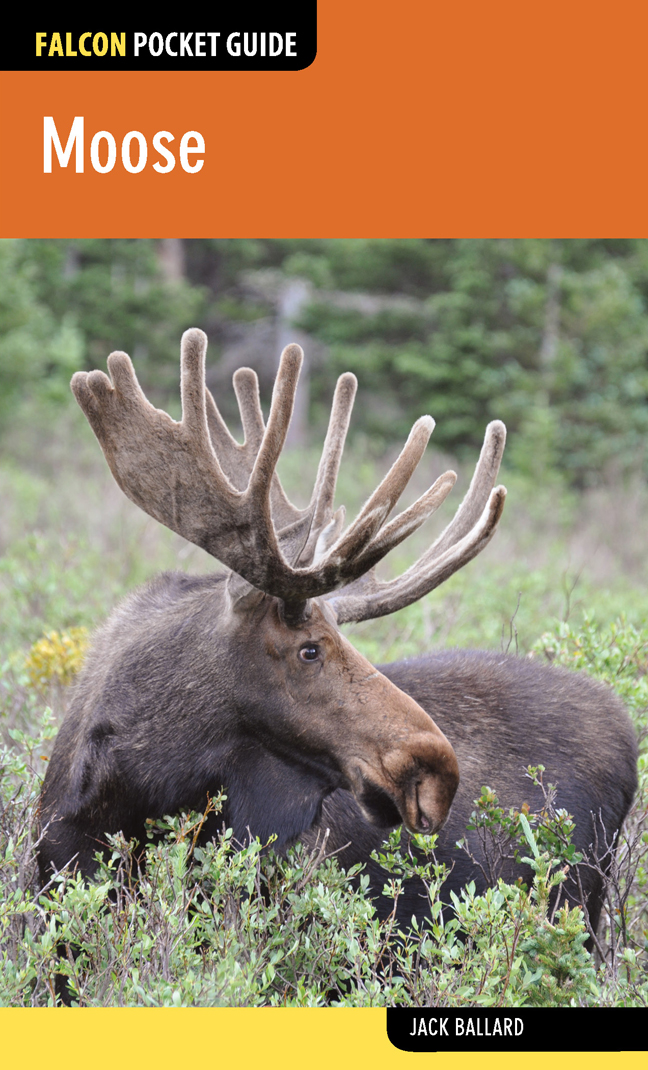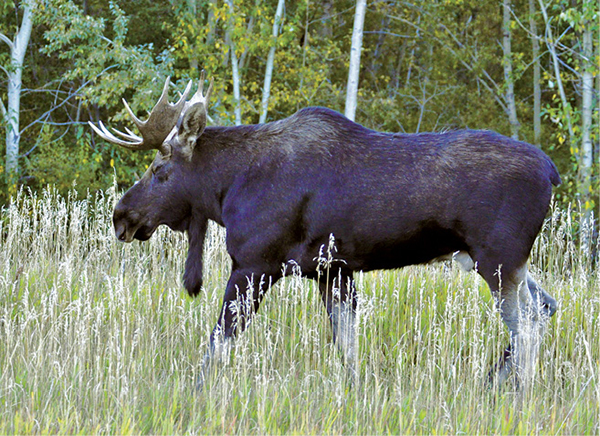MOOSE
Jack Ballard
Copyright 2014 Morris Book Publishing, LLC
ALL RIGHTS RESERVED. No part of this book may be reproduced or transmitted in any form by any means, electronic or mechanical, including photocopying and recording, or by any information storage and retrieval system, except as may be expressly permitted in writing from the publisher. Requests for permission should be addressed to Globe Pequot Press, Attn: Rights and Permissions Department, PO Box 480, Guilford, CT 06437.
FalconGuides is an imprint of Globe Pequot Press.
Falcon, FalconGuides, and Outfit Your Mind are registered trademarks of Morris Book Publishing, LLC.
Photos by Jack Ballard unless noted otherwise.
Project editor: Staci Zacharski
Text design: Sheryl P. Kober
Layout: Sue Murray
Library of Congress Cataloging-in-Publication Data is available on file.
ISBN 978-1-4930-1033-2
The author and Globe Pequot Press assume no liability for accidents happening to, or injuries sustained by, readers who engage in the activities described in this book.
Moose have occasionally been described as having a face only a mother could love. This book is dedicated to the unwavering love of my own mother.
Contents
Acknowledgments
Special thanks for their assistance with this book are offered to two individuals. The first goes to Sarah Dewey, wildlife biologist at Grand Teton National Park in Wyoming. Sarah has been intimately involved with moose research. Her insights while reviewing the book were instrumental in helping the author revise several fine points. I also owe my sweetheart, Lisa, many thanks. She has selflessly shared photos for this book (and others in this series) and offered numerous stylistic suggestions that greatly improved the manuscript.
Introduction
Lets see how close we can get to those moose.
Not one to let a challenge pass, I eagerly accepted the invitation from my older brother. We were in our early twenties, hunting deer deep in Montanas Absaroka-Beartooth Wilderness. Moments earlier wed spied four bull moose bedded at the edge of the timber, about a half-mile from our position.
When we crept from cover, a scant 150 yards from the bulls, eight moose eyes were already focused in our direction. Though I didnt realize it at the time, the animals keen ears had doubtlessly detected our best sneaking. The moose didnt seem alarmed, so we strolled closer. At 50 yards it suddenly seemed too close. Just then, the largest member of the bachelor band rose to his feet, cocked his antlers in our direction, and snorted forcefully. The fact both of us were carrying rifles didnt matter. Our retreat was mirthless and hasty.
A couple of years later, while hiking in the same drainage, I happened upon a very large shed antler from a bull moose. In a lifetime of collecting a varied assortment of treasures from the wild, it is perhaps my most prized memento. It lay collecting dust in the garage for two decades. Struck with inspiration, I recently fashioned it into an elegant chandelier that now graces the table above a family retreat in New Yorks Adirondack Park.
Moose are fascinating creatures, both in appearance and behavior. At the present time, theyre not thriving in the contiguous United States. Populations remain healthy in some areas and in the past decade have actually expanded in a few places. But across the board, moose are suffering. Populations have plummeted in states such as Minnesota and New Hampshire. More gradual but significant declines have occurred in the northern Rocky Mountains.
Are these decreases temporary setbacks in historically fluctuating numbers or the beginning of a serious downward spiral in American moose populations? More time and research are needed to answer that question. In the meantime, I hope this book will increase the readers knowledge of this singular species and encourage a commitment to the conservation of moose.
CHAPTER 1 Names and Faces
Names and Visual Description
The moose is the largest antlered animal in North America. Bison are the only land animal on the continent that weigh more than moose. However, the average adult moose is as tall as a bison. Moose have very long legs. They exhibit a dark brown or black appearance overall, with lighter, grayish fur on the lower portions of their legs. The belly and inside of the legs are also grayish. On overcast days or in low light, the coat of some moose often looks very black. While their dominant coloration is similar, the coats of males and females differ in certain ways. Males have a very dark muzzle, while the muzzle of a cow is medium or light brown. Both sexes have a short, stubby tail. Cows have a light patch of fur just below their tail. In the spring, prior to shedding their winter coat, the fur on moose may appear lighter and more faded than at other times of the year.
Viewed from the side, a moose is a lanky creature that may remind some people of a horse. Moose have a long face terminating in a somewhat bulbous snout. The upper lip of a moose overlaps noticeably with its lower lip. Their front shoulder is humped, while a curious flap of skin and hair dangles below their chin. The purpose of this strange appendage (if there is one), known as the bell or dewlap, is unknown to biologists. The dewlap is larger and more easily spotted on mature males than on cows or young animals.
The flap of skin below a mooses chin is called the bell or dewlap and is more pronounced on bulls than on cows.
The term moose originates in the native Algonquian language of American Indians historically inhabiting the northeastern United States and southeastern Canada. In the native language, moose refers to these animals habit of nibbling twigs and stripping bark from trees. Thus, the creatures name aptly captures its dominant eating habit in the native language. Linguists believe the term moose entered the English language from Algonquian very early in the seventeenth century. The scientific name for the moose is Alces alces.
Moose were confused with a related North American mammal, the elk, by early European immigrants. In Europe and Great Britain, the common name of the Alces alces species is elk. In fact, the Latin term alces , whence the scientific name of the moose is derived, means elk. Early European settlers to North America may have never seen a Eurasian elk or moose ( Alces alces ), but they were aware of its existence as a large, antlered creature. When they arrived to the New World and encountered North American elk ( Cervus elephus ), they mistakenly named them for the Eurasian creature of the same name. Thus, the North American animal we know as the moose is commonly referred to as the elk in Europe.
Related Species in North America
The moose is the largest member of the deer family, a group of antlered animals with cloven hooves. Due to their massive size and unique color, competent observers are unlikely to mistake a moose for any other member of the deer family, although elk hunters have been known to accidentally shoot moose, thinking they are elk. Moose are much taller than elk, usually standing a foot or more higher at the front shoulder. While moose have an overall dark brown or blackish appearance, elk are tawny or light brown across most of their body, with darker brown fur on their neck and head and a prominent yellow or tannish colored rump. The face of an elk is noticeably shorter than that of a moose. An elks muzzle tapers to a slender nose and mouth, while the nose of a moose appears round and bulging.


